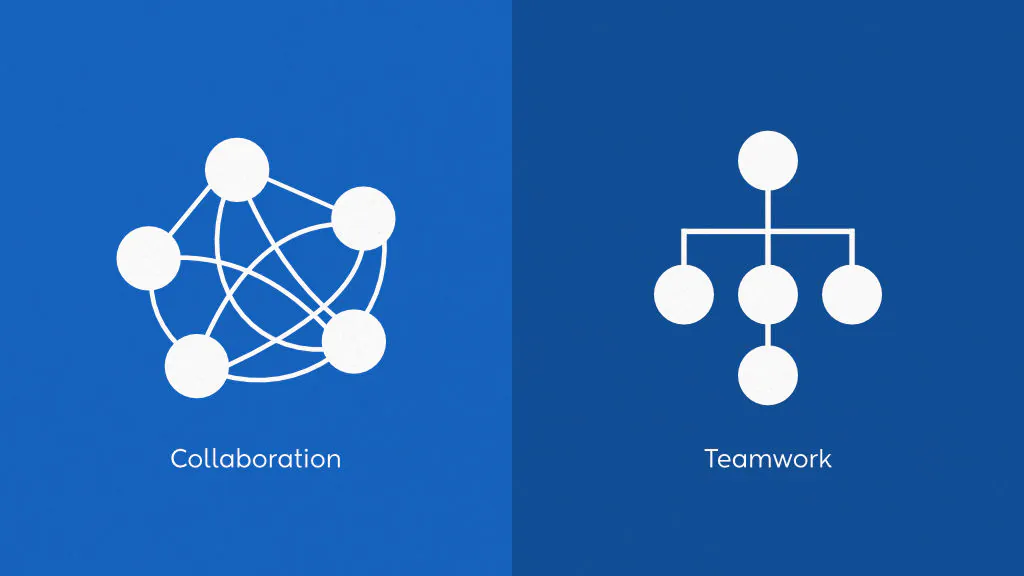
Collaboration refers to people working together by integrating diverse expertise, jointly making decisions, and sharing accountability for outcomes. Teamwork involves people working within defined roles, executing assigned tasks within a structured process to achieve a common goal.
The primary difference between collaboration and teamwork lies in how outcomes are achieved. Collaboration relies on shared input, fluid roles, and collective ownership, while teamwork depends on hierarchy, role clarity, and coordination for efficiency.
Both approaches are essential in organizations. Collaboration is critical for innovation, strategy, and solving complex problems, while teamwork ensures structured execution, discipline, and timely delivery.
In this article, we explain what collaboration and teamwork are, their differences, benefits, and limitations, examples from workplace scenarios, and situations where each is most effective.
What is collaboration?
Collaboration is the structured process of two or more individuals, teams, or organizations working together to achieve a shared goal, leveraging complementary skills, knowledge, and resources. Unlike simple coordination, collaboration involves joint decision-making, shared accountability, and integrated workflows.
It improves efficiency, quality, and innovation by aligning diverse expertise, minimizing silos, and ensuring transparent communication. Collaboration is measured through collective output, task interdependencies, and team alignment with objectives rather than individual performance alone.
What is teamwork?
Teamwork is the coordinated effort of individuals working together to complete tasks and achieve a common objective, where roles and responsibilities are clearly defined. Unlike collaboration, teamwork emphasizes task execution and efficiency over shared decision-making or joint problem-solving.
It ensures accountability, predictable outcomes, and role clarity within a team structure. Teamwork is measured through individual contributions, adherence to assigned tasks, and successful completion of collective goals.
7 Differences between collaboration and teamwork
Collaboration integrates diverse expertise, joint decision-making, and shared accountability, while teamwork focuses on executing assigned tasks efficiently under defined roles. Understanding these differences is essential to apply the right approach in organizations for innovation, productivity, and alignment.
Here is a brief comparison table of collaboration and teamwork, followed by a detailed analysis:
| Attribute | Collaboration | Teamwork |
| Required skills | Critical thinking, problem-solving, adaptability, negotiation, creative ideation | Task execution, reliability, time management, following instructions |
| Leadership and decision-making | Shared or rotating leadership, consensus-driven decisions | Centralized leadership, top-down decisions |
| Hierarchical Structure | Flat, equality-focused, participative | Structured, hierarchical, manager-directed |
| Communication style | Transparent, continuous, multi-directional | Task-focused, primarily top-down or lateral |
| Team Roles | Flexible, assigned based on expertise and project needs | Fixed roles, predefined responsibilities |
| Tools and technology | Collaboration platforms, shared documents, real-time communication, visualization tools | Task management software, workflow trackers, reporting tools |
| Success metrics | Collective output, integration of ideas, alignment with objectives | Task completion, deadlines, individual performance within team goals |
1. Required skills
- Collaboration requires critical thinking, problem-solving, adaptability, negotiation, and creative ideation. Team members must integrate diverse expertise, adapt to changing requirements, and jointly develop solutions.
- On the other hand, teamwork requires task execution, reliability, time management, and following instructions. Team members focus on completing assigned duties efficiently and accurately.
2. Leadership and decision-making
- In collaboration, leadership is shared or rotates, allowing members to influence decisions. Decisions are consensus-driven and incorporate multiple perspectives.
- Whereas in teamwork, leadership is centralized. Decisions follow a top-down model, with members executing predefined instructions.
3. Hierarchical structure
- Collaboration operates in a flat structure, promoting equality, active participation, and trust. Every member has input in discussions and decisions.
- Teamwork follows a structured, hierarchical model with clearly defined roles and reporting lines.
4. Communication style
- Collaboration requires transparent, continuous, and multi-directional communication to share insights and align efforts. Feedback loops are frequent and iterative.
- In teamwork, communication is task-focused and primarily top-down or lateral, aimed at coordinating tasks rather than integrating ideas.
5. Team roles
- Roles in collaboration are flexible, dynamic, and assigned based on expertise and project needs. Members may take on different responsibilities as the project evolves.
- Roles in teamwork are fixed, established at the start, and maintained throughout the project. Each member is accountable for specific tasks only.
6. Tools and technology
- Collaboration uses interactive platforms, shared documents, real-time communication tools, and visualization software for coordination, tracking, and integration.
- Teamwork relies on task management software, workflow trackers, and reporting tools for monitoring deadlines, task completion, and individual accountability.
7. Success metrics
- Collaboration is measured by collective output, integration of ideas, alignment with shared objectives, and innovation effectiveness. Success depends on synergy among members.
- Teamwork is measured by task completion rates, adherence to deadlines, and individual contributions. Success depends on efficiency and meeting predefined goals.
Collaboration and teamwork both enhance organizational performance, but they deliver value differently. Understanding their benefits and limitations ensures proper application for efficiency, innovation, and alignment.
What are the benefits of collaboration?
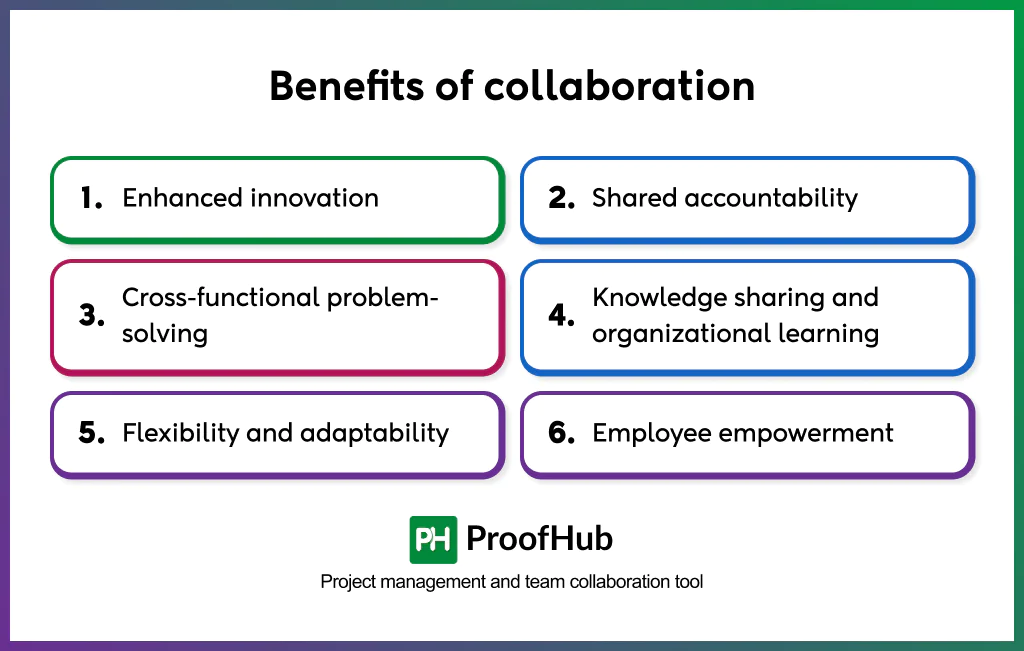
Some of the prominent benefits of collaboration are:
1. Enhanced innovation: Collaboration creates an environment where diverse professional expertise, experiences, and perspectives intersect. This exchange generates new ideas, encourages experimentation, and supports solutions that do not emerge within rigid, role-bound teamwork.
2. Shared accountability: Collaboration distributes responsibility across all members. Success and failure are owned collectively. This ensures risk-sharing, prevents over-dependence on a single individual, and reduces bottlenecks when one member is unavailable.
3. Cross-functional problem-solving: Collaboration integrates expertise from different departments or disciplines, which enables the team to approach challenges holistically. Cross-functional collaboration improves problem-solving by revealing blind spots and addressing interconnected challenges across strategy, operations, and technology.
4. Knowledge sharing and organizational learning: Collaboration eliminates silos by promoting constant information flow. Team members exchange insights openly, and knowledge is collectively built rather than individually retained. This results in stronger institutional memory and faster onboarding for new members.
5. Flexibility and adaptability: Collaboration operates with fluid roles and responsibilities. Members can shift tasks dynamically depending on project needs. This flexibility supports quick adaptation to unexpected challenges, evolving goals, or environmental changes.
6. Employee empowerment and engagement: Collaboration empowers every member to contribute ideas and decisions. This inclusion increases ownership, trust, and motivation, leading to higher engagement compared to task-based teamwork.
What are the limitations of collaboration?
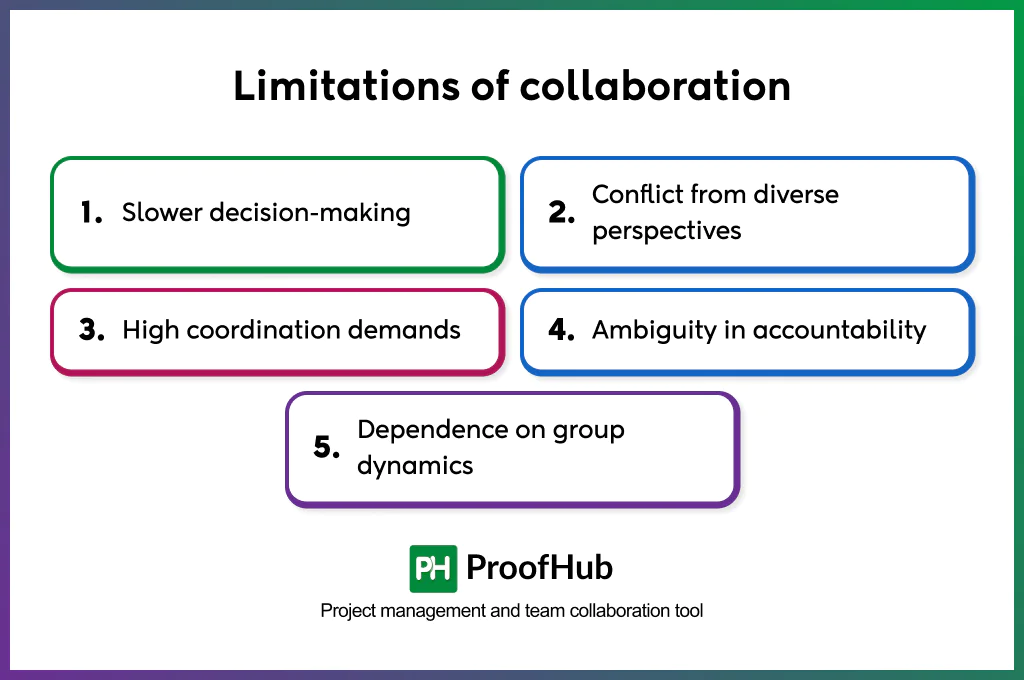
Below are some limitations of collaboration:
1. Slower decision-making: Collaboration requires consensus among members before decisions are finalized. While this ensures inclusivity, it significantly slows down processes, especially in urgent or high-pressure situations.
2. Conflict from diverse perspectives: Different backgrounds and viewpoints increase the likelihood of disagreements. When conflicts are not managed effectively, they delay progress and reduce team cohesion.
3. High coordination demands: Collaboration requires extensive time, tools, and processes to align members. Scheduling, task distribution, and information exchange demand significant effort compared to teamwork’s simpler hierarchy.
4. Ambiguity in accountability: Shared responsibility, while beneficial for ownership, reduces clarity in performance tracking. Identifying underperformance or assigning credit becomes difficult when outcomes are co-owned.
5. Dependence on group dynamics: Collaboration’s effectiveness relies heavily on trust, engagement, and active participation. When team dynamics are weak, collaboration breaks down, leading to inefficiency and frustration.
What are the benefits of teamwork?
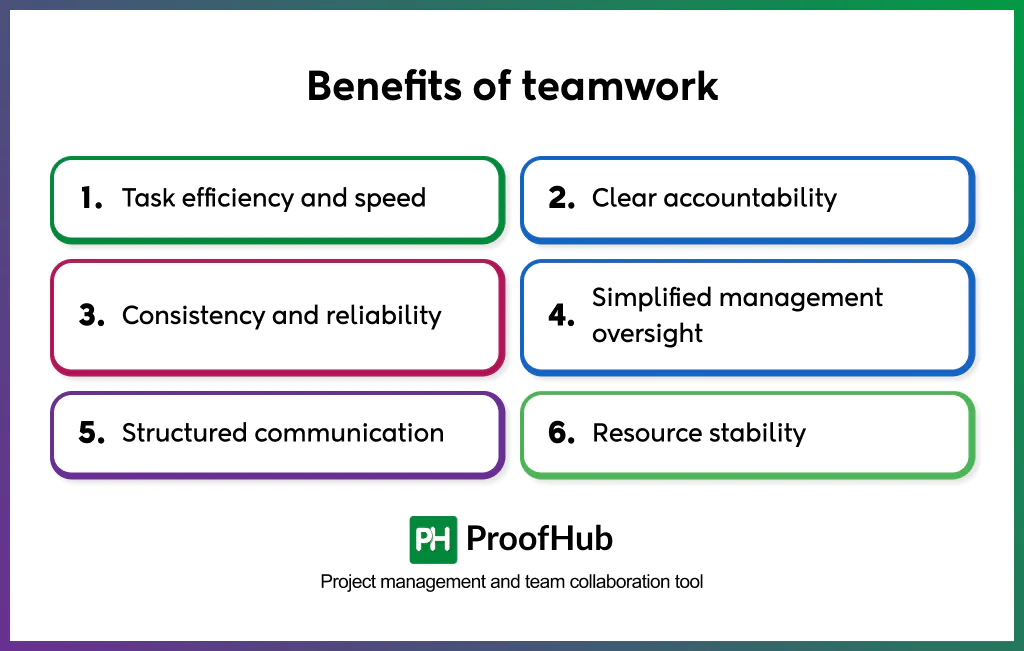
Here are some key benefits of teamwork:
- Task efficiency and speed: Teamwork is designed for rapid execution because roles, responsibilities, and workflows are predefined. Members focus on specific tasks without negotiating responsibilities or redefining goals during execution.
- Clear accountability: Each member has defined deliverables, making it easy to measure individual performance and track progress. Unlike collaboration, there is no ambiguity about who is responsible for what.
- Consistency and reliability: Teamwork produces predictable outcomes because structured processes are followed. Repetition within the same framework reduces performance variance.
- Simplified management oversight: Hierarchical structures in teamwork make monitoring straightforward. Team leaders can track progress, resolve bottlenecks, and ensure alignment without involving the entire group in decision-making.
- Structured communication: Information flows along predefined lines, usually top-down or task-oriented. This reduces information overload and keeps communication focused on execution.
- Resource stability: In teamwork, roles remain fixed, ensuring stability in resource allocation. Members know their tasks, reducing overlap and dependency conflicts.
What are the limitations of teamwork?
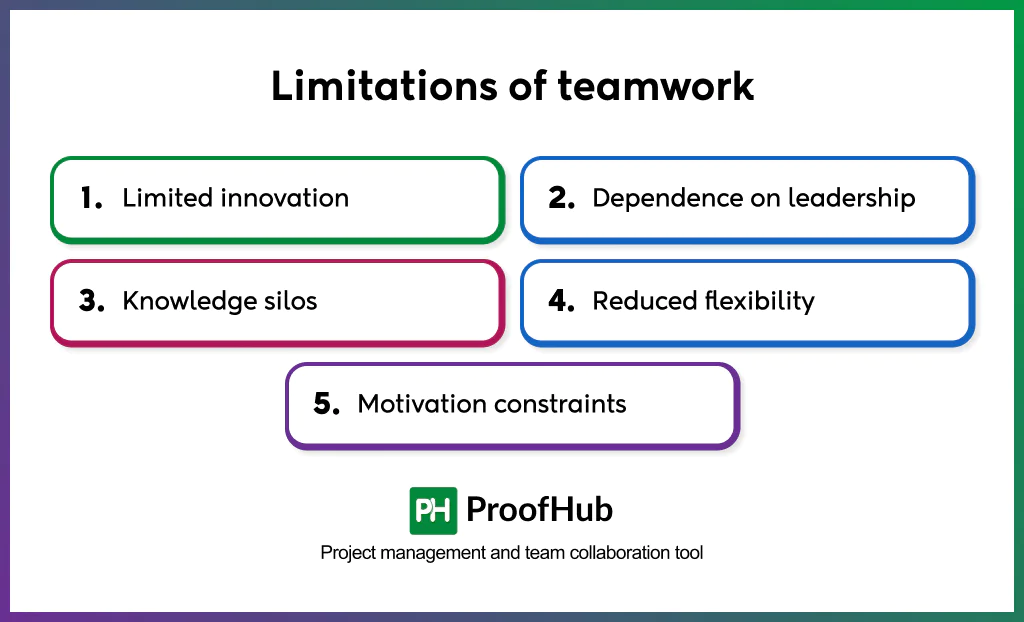
Some limitations of teamwork include:
- Limited innovation: Teamwork operates within predefined roles and hierarchical decision-making. This structure restricts experimentation and the exchange of creative ideas.
- Dependence on leadership: Decision-making in teamwork is centralized with managers or team leaders. If leadership is ineffective, decision quality and speed decline.
- Knowledge silos: Since teamwork is role-bound and department-specific, knowledge sharing across functions is minimal. Expertise remains within silos, limiting broader organizational learning.
- Reduced flexibility: Teamwork assigns fixed responsibilities to ensure clarity. While efficient, this rigidity prevents members from adapting quickly to changing conditions.
- Motivation constraints: Teamwork emphasizes task completion over contribution in decision-making. Creative or highly skilled members may feel underutilized, leading to disengagement.
Examples of collaboration
- New product development in a tech company
A software company wants to launch a new AI-powered feature. Instead of leaving the responsibility to only the development team, engineers, product managers, data scientists, and UX designers collaborate in joint workshops.
Each member contributes their perspective – engineers on feasibility, data scientists on models, designers on usability, and product managers on customer needs. The final product emerges from collective decisions rather than a single department’s directive.
- Marketing campaign brainstorm
A global brand needs a fresh campaign. The marketing, creative, social media, and analytics teams gather in brainstorming sessions using digital whiteboards.
Designers sketch ideas, marketers shape the messaging, and analysts validate concepts with audience insights. Each idea is challenged, refined, and improved through dialogue, producing a campaign that feels innovative and well-rounded.
- Sustainability initiative across departments
An organization commits to reducing carbon emissions. Rather than HR, operations, or finance working independently, all departments collaborate.
HR introduces green employee programs, finance models, cost-saving benefits, operations, streamline logistics, and IT digitises workflows. Success is possible only because expertise is shared across silos.
Examples of teamwork
- Software development sprint execution
A tech company is rolling out updates for an app. The product manager assigns tasks – developers code features, testers run QA checks, and DevOps handles deployment.
Each role works independently but in sync, following a sprint backlog. The process is structured, deadlines are fixed, and leadership ensures tasks are completed in sequence.
- Corporate event execution
A company is hosting its annual conference. The event manager oversees the schedule, logistics staff arrange the venue, the catering team handles food, and IT staff set up audiovisual systems.
Each member executes assigned duties with little overlap, and success is measured by smooth delivery on the day of the event.
- Construction site operations
On a building project, the architect provides the blueprint, the engineers plan the structure, and the workers carry out construction tasks under a site supervisor.
Instructions flow top-down, and each worker executes their part. Teamwork ensures that tasks are completed step by step until the building is finished.
When should you collaborate?
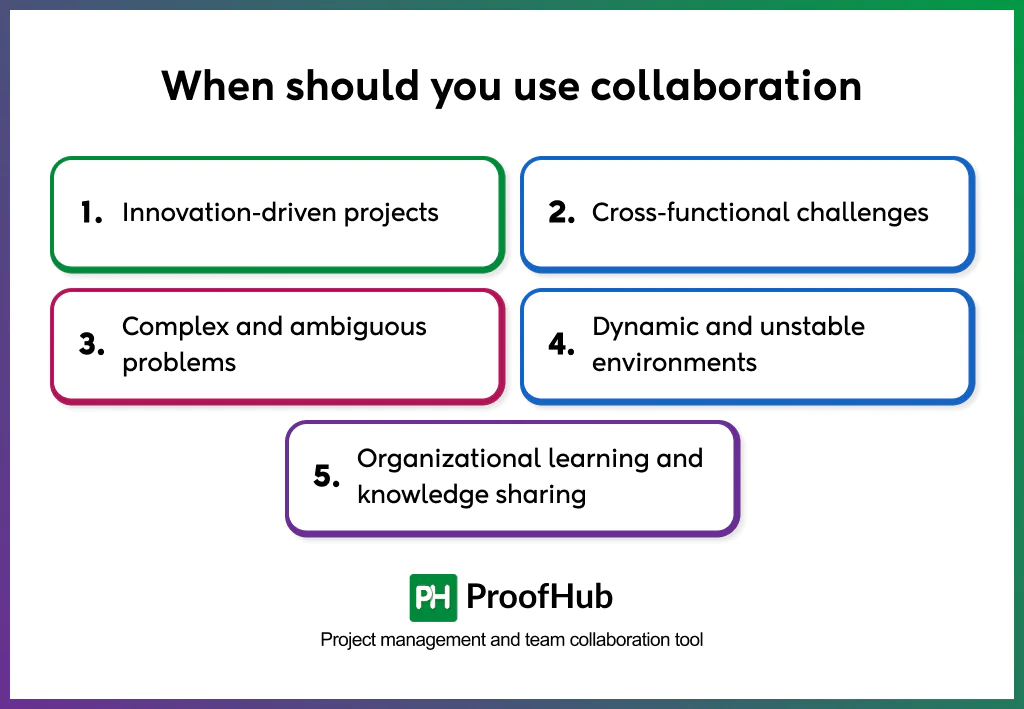
You should use collaboration when your projects need innovation, diverse expertise, and adaptability. It is most effective in solving complex problems, building long-term strategies, and driving organizational learning.
- Innovation-driven projects: Collaboration is required when the goal is to create new products, services, or solutions. Diverse perspectives allow experimentation and breakthrough ideas that structured teamwork cannot achieve.
- Cross-functional challenges: When projects cut across multiple departments, collaboration prevents siloed decision-making. It integrates knowledge from different functions to address interconnected issues.
- Complex and ambiguous problems: Collaboration should be applied when solutions are not straightforward and require exploration. Multi-perspective input reduces blind spots and uncovers effective strategies.
- Dynamic and unstable environments: Collaboration is effective in industries or projects where conditions change frequently. Adaptive roles and fluid responsibilities make it possible to pivot quickly.
- Organizational learning and knowledge sharing: When the objective is to build long-term capabilities, collaboration enhances collective knowledge. It ensures that expertise is shared, documented, and retained.
When should you use teamwork?
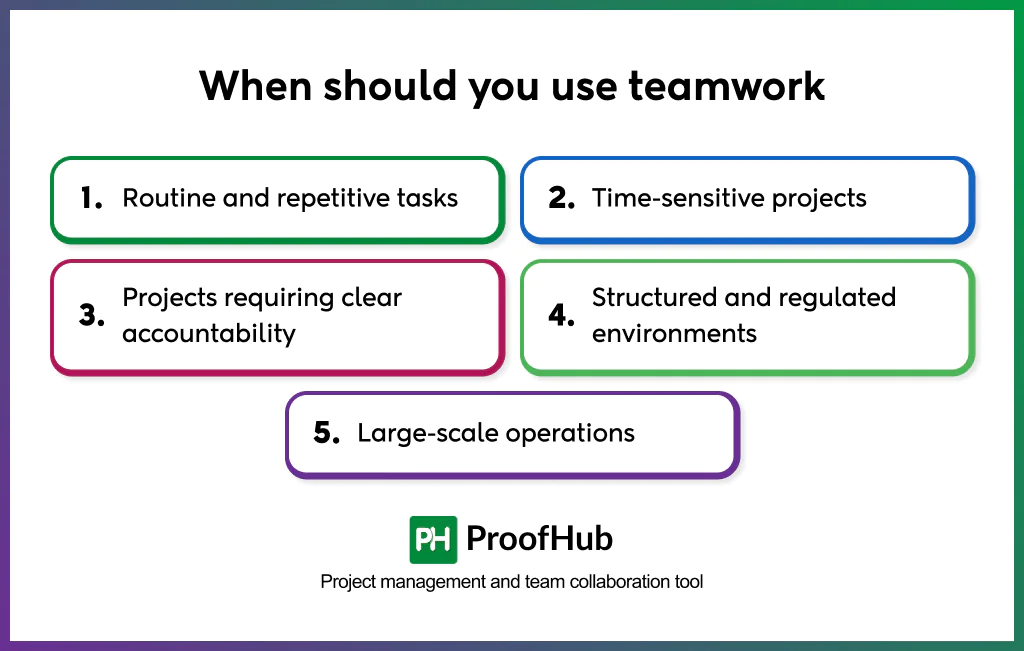
You should use teamwork when your projects require speed, efficiency, and structured execution under predefined roles. It is most effective for operational tasks, routine objectives, and short-term deliverables.
- Routine and repetitive tasks: Teamwork is ideal for projects that follow standardized processes with predictable outcomes. Clear roles reduce errors and maintain consistency.
- Time-sensitive projects: When deadlines are strict, teamwork allows rapid execution because decisions are centralized and roles are already defined.
- Projects requiring clear accountability: Teamwork ensures that each deliverable has a responsible individual, which simplifies performance measurement and reporting.
- Structured and regulated environments: In industries with strict rules and compliance needs, teamwork’s hierarchical oversight ensures adherence to standards.
- Large-scale operations: Teamwork suits projects that require stability and resource allocation across many participants. Fixed roles reduce dependency conflicts and keep operations smooth.
Can collaboration and teamwork coexist?
Yes, collaboration and teamwork coexist in organizations when creativity and efficiency are balanced within the same workflow. Collaboration is applied to generate ideas, integrate diverse expertise, and decide on innovative approaches, whereas teamwork is used to execute those decisions through defined roles and structured processes.
What skills support both collaboration and teamwork?
Collaboration and teamwork share a set of core skills that ensure effectiveness, alignment, and sustained outcomes. Here are some skills that support both collaboration and teamwork:
- Communication: Clear articulation, active listening, and timely updates maintain alignment and prevent misunderstandings.
- Problem-solving: Both require identifying issues, analyzing options, and applying solutions effectively.
- Interpersonal skills: Empathy, adaptability, and trust-building strengthen cohesion in any group setting.
- Leadership: The ability to guide, motivate, and influence others; flexible in collaboration and structured in teamwork.
- Decision-making: Reaching agreements efficiently; often consensus-driven in collaboration and authority-driven in teamwork.
- Conflict resolution: Managing disagreements constructively to keep progress steady.
- Accountability: Taking responsibility for contributions, whether shared (collaboration) or individual (teamwork).
How do collaboration and teamwork tools differ?
Tools for collaboration emphasize co-creation and idea sharing, while tools for teamwork focus on task execution and coordination.
Collaboration platforms provide shared workspaces where multiple people can contribute simultaneously, brainstorm in real time, and refine outputs collectively. These tools reduce hierarchy by giving equal access to information and enabling everyone to add input, making them suitable for innovation and problem-solving.
On the other hand, teamwork tools are structured around task assignment, progress tracking, and role-based accountability. They ensure clarity on responsibilities, deadlines, and dependencies, which supports the efficient delivery of planned work. Information flow is more directional; updates move from individuals to leaders and back to the group, reflecting the structured nature of teamwork.
The key difference is that collaboration tools create shared ownership of outcomes, while teamwork tools maintain individual accountability within defined roles. Both sets of tools are essential, but their use depends on whether the focus is on generating new ideas together or completing established tasks in sequence.






